| THIS WEEK'S ARTICLES |
| The Mindful Investor |
| Breakdown in Mega-Cap Growth Confirms Bear Phase |
| by David Keller |
While our major equity benchmarks showed incredible strength in Q1 2024, breadth conditions have been deteriorating since mid-March. Despite the weakening breadth readings, and the initial breakdowns of the S&P 500 and Nasdaq 100, leading growth names, including the formerly-described Magnificent 7 stocks, had remained in clearly-defined uptrends.
This week, some of the top-performing stocks in the S&P 500 finally broke below their 50-day moving averages. While this signal on its own is not a sign of a market top, these breakdowns represent just one of the many clear signals that the bull market off the October 2023 low may be over.
Today, we'll briefly review some of the early breakdowns in the mega-cap growth space, how some of the top-ranked SCTR stocks have shown recent weakness, and why the "Fantastic Four" (current front-runner to replace the "Magnificent 7 moniker) breaking down may represent a key confirmation for a new bear phase.
The Early Breakdowns: Apple (AAPL) & Tesla (TSLA)
Tesla has been in a confirmed downtrend since July 2023, and Apple has appeared in a weak technical configuration since failing to break above the $200 level in December and January. But both charts have literally and figuratively made a new low this week.
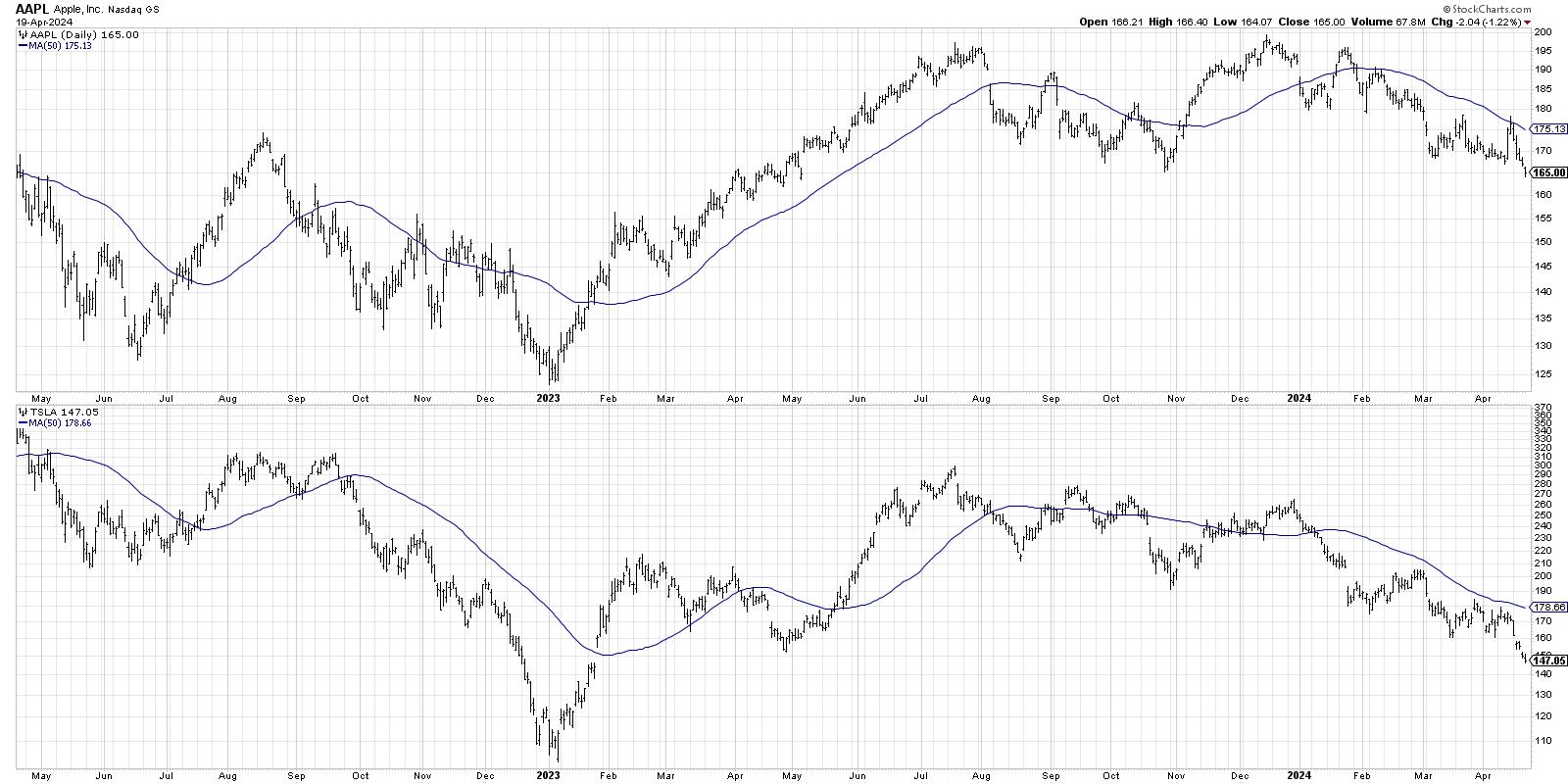
Note how both charts have remained below downward-sloping 50-day moving averages since mid-January. Also observe how both have shown failed attempts to break above that moving average in recent months. When stocks are making lower lows and lower highs, and trending below downward-sloping moving averages, I've learned it's best to avoid taking action until some of those conditions start to change.
Ready to talk market breadth indicators? Our next free webinar, Breaking Down Breadth, will focus on breadth conditions now vs. previous market tops. Join me on Tuesday, April 23rd at 1pm ET as we review the current market environment through the lens of breadth indicators, compare them to conditions at previous market tops, and discuss the likelihood of further drawdowns for the S&P 500 and Nasdaq. Sign up HERE for this free webcast!
As these stocks broke down, diverging from most other leading growth names, the S&P 500 and Nasdaq 100 pushed much higher. So let's see some of the stocks that served as leadership in Q1.
The Top-Ranked SCTRs: Super Micro Computer (SMCI) & MicroStrategy (MSTR)
Here, we have two names that were less well-known until they experienced exponential gains earlier this year. And while they certainly appeared overextended in March, they have now both come right down to earth.
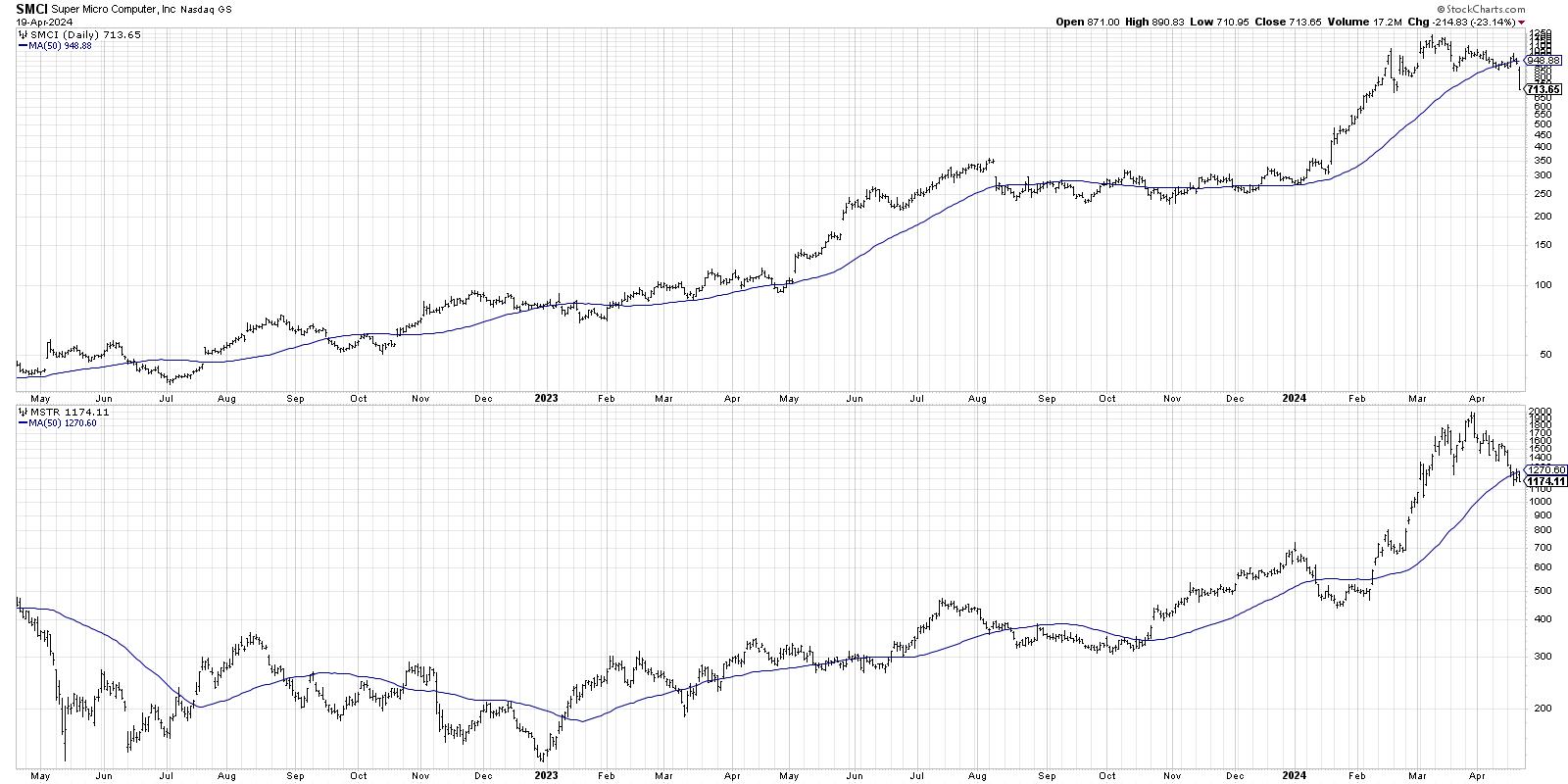
From the end of 2023 to their peaks in March 2024, SMCI and MSTR gained 350% and 175%, respectively. They both were a far distance from moving average support, giving clear signs of overbought conditions. So far in April, both stocks have traded much lower, and they each finished this week below their 50-day moving averages.
It's normal for stocks in strong uptrends to pull back and test moving average support. Indeed, the 50-day moving average often serves as a potential entry point for a "buy on the dips" strategy. But when top performers fail to hold this crucial short-term support level, I have found that it often implies a broader move to more risk-off positioning.
What about the best of the biggest--in other words, the most magnificent of the Magnificent 7?
The Fantastic Four Breakdowns: Netflix (NFLX) & Amazon (AMZN)
That brings us to perhaps the most concerning development this week. As I recently posted on my social media accounts, "As long as $AMZN and $NFLX remain above the 50-day moving average, you can make an argument for ‘short-term pullback' as opposed to ‘protracted and painful decline.'" Unfortunately, this week, we finally observed this breakdown of breakdowns.
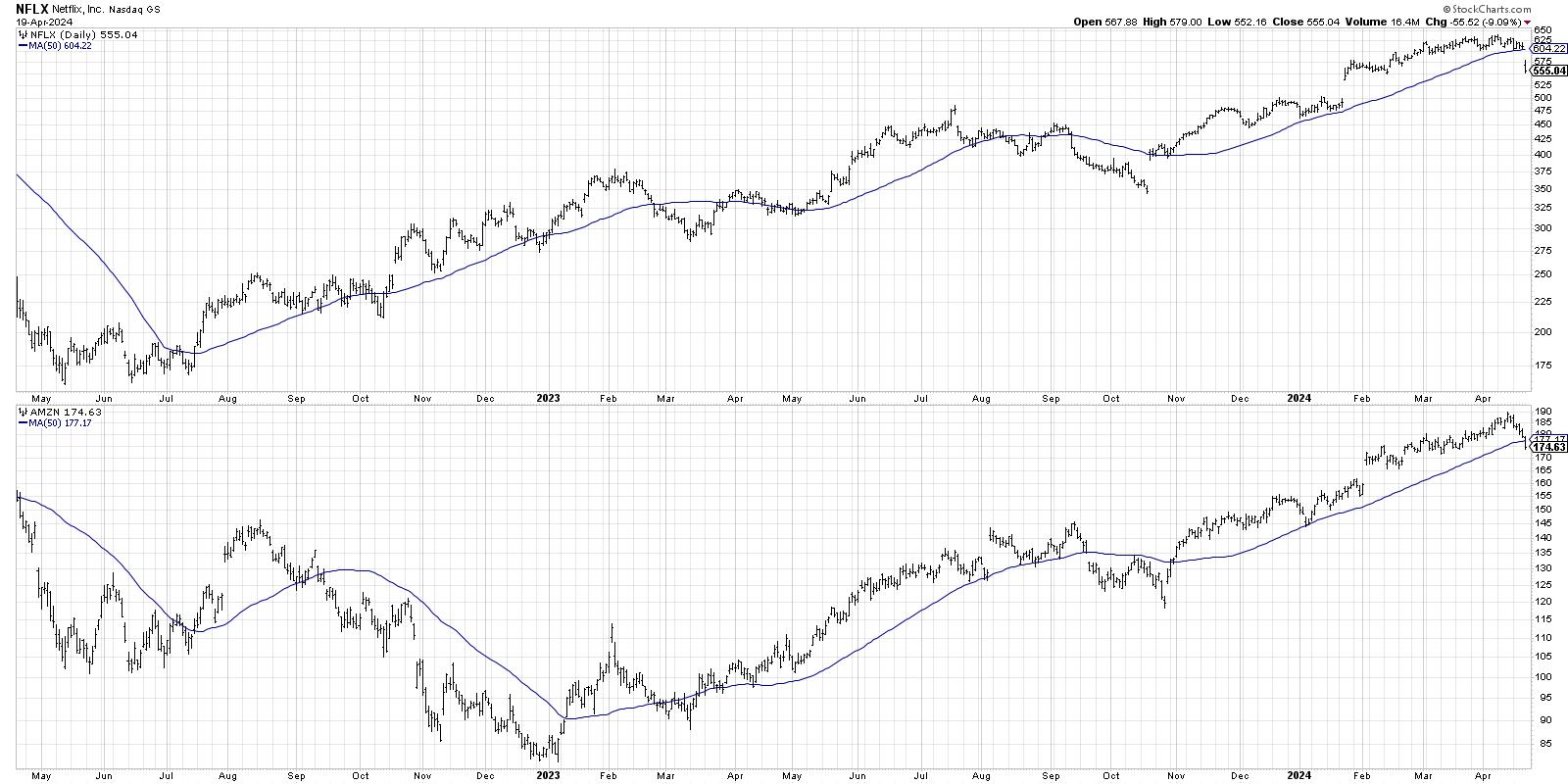
Mega-cap growth stocks wield an outsized influence on our top-heavy growth-dominated equity benchmarks. In recent weeks, bearish momentum divergences, weakening breadth conditions, and breaks of "line in the sand" support levels had us thinking market weakness over market strength. But the resilience of the Fantastic Four stocks gave us just a glimmer of hope that a pullback may be limited.
Given this week's breakdown in the charts of previous top performers, we feel this just may be the beginning of the great bear phase of Q2 2024.
RR#6,
Dave
P.S. Ready to upgrade your investment process? Check out my free behavioral investing course!
David Keller, CMT
Chief Market Strategist
StockCharts.com
Disclaimer: This blog is for educational purposes only and should not be construed as financial advice. The ideas and strategies should never be used without first assessing your own personal and financial situation, or without consulting a financial professional.
The author does not have a position in mentioned securities at the time of publication. Any opinions expressed herein are solely those of the author and do not in any way represent the views or opinions of any other person or entity.
|
| READ ONLINE → |
|
|
|
| Martin Pring's Market Roundup |
| MEMBERS ONLY |
| Precious Metals Reach Exhaustion |
| by Martin Pring |
|
In the last couple of weeks, I have been reading stories about shoppers picking up gold bars in, of all places, Costco. According to Gemini, the AI branch of Google, "Reports indicate they may be selling up to $200 million worth of gold bars every month...
|
| READ ONLINE → |
|
|
|
| Fill The Gap by CMT Association |
| Important Inflection Point in FXI: Is It Time To Accumulate? |
| by Stewart Taylor |

The iShares China Large-Cap exchange-traded fund (FXI) holds the 50 largest large-cap Chinese stocks that trade on the Hong Kong exchange.
FXI could soon make a secondary test of its 2022 low. A successful test will show strength, but a failed test will show weakness. Either outcome can produce a meaningful directional move offering multiple trading opportunities. This is the kind of setup or juncture around which I like to build agnostic trading plans. Either way, I will have a trading and risk management plan in place to take advantage of either outcome.
In a macro sense, there isn't much going on in China, leading me to optimism. China is a command economy run by a communist regime in the process of retreating from capitalism. Importantly, leadership seems to be increasingly resistant to providing adequate fiscal stimulus. To that list, you can add a rapidly aging population, a world increasingly resistant to buying their goods, a rethinking of global supply lines, and significant raw material and climate challenges. Granted, there are positives. They are becoming a microchip superpower and have made significant technological advances over the last five years. In my view, the negatives outweigh the positives by quite a lot.
My macro view informs my aggressiveness and risk tolerance. But if a technical setup provides a clear risk-reward advantage, a conflicted macro view never deters me from making a trade. Technical setups are far more actionable than fundamental beliefs. And it is always good to remember that, the more widely accepted a viewpoint becomes, the more susceptible a market becomes to mean reversion or reversal.
Monthly Perspective of FXI
The monthly chart of FXI below shows some significant technical developments.

FIGURE 1: MONTHLY CHART OF FXI.
Chart Takeaways:
- FXI is confined within the more extensive 13.43–50.80 range developed since the ETF began trading (four years after China joined the World Trade Organization).
- In 2021, after slightly up-thrusting the October 2007 high, the market began a vicious decline (-60%). The decline from the February 2021 high occurred on rising volume and a wide price spread (suggesting strong-handed selling). The move was impulsive.
- In early 2022, FXI fell out of the broad rising channel (A-B, C-D) that had defined the general price action for most of the prior 15 years.
- The fallout of the channel created strong selling, but a temporary selling climax developed (red arrow) as the market reached the lateral support at 23.05 and opportunistic buying emerged.
- The minor climax produced a small automatic rally that quickly ran into resistance along the lows of the broken channel. The market then devolved into a four-month show of weakness.
- The weakness occurred on a wide price spread and growing volume before potentially developing a complex selling climax (SC). Note that while the SC appears complex in this perspective, it appears more traditional in the daily perspective.
- The automatic rally (AR) lasted four months and found resistance in the same 32–33.00 zone that had turned the market lower in March 2022.
- After testing the resistance, FXI began setting back toward the selling climax low (19.81). Note that during the most recent decline, the angle of decline was shallower than that of the larger (50.80–19.81) decline and that the volume has been somewhat lighter. The shallower angle and lighter volume suggest less supply entering than on the prior decline.
- The recent pullback toward the October 2022 low may be developing as a secondary test. The outcome of that test is likely to develop into a significant directional move.
- The solid volume expansion around the recent low (ST?) suggests strong-handed buying and that the secondary test may be complete, pending a show of strength.
Let's turn to momentum.
FXI Monthly Momentum

FIGURE 2: MOMENTUM IN FXI. The MACD histogram has turned positive. A push to the upper half of the Bollinger Band would be positive for FXI.Chart source: StockChartsACP. For educational purposes.Momentum takeaways:
- Momentum is diverging significantly from price, and the Moving Average Convergence/Divergence Oscillator (MACD) histogram has turned positive. This oscillator condition and strength from this position in the trend would be highly positive.
- Price has been confined in the lower portion of the Bollinger Band since July 2021. A push into the upper half of the band would mark a significant change in the market's character. Note that the B-band is narrow. Narrow B-bands often immediately precede trending moves.
Weekly Perspective of FXI
After evaluating the monthly perspective, I will turn to the weekly perspective. I prefer to trade in this (the weekly) perspective.

FIGURE 3. WEEKLY CHART OF FXI. If the ETF moves well above the recent downtrend (A-B) and the volume and price spread expands, consider bullish setups.Chart source: StockChartsACP. For educational purposes.
Chart takeaways:
- The price/volume relationships detailed in the monthly perspective are seen more clearly.
- The false selling climax at A, complex climax at B, automatic rally to 32.36, and low volume decline (note the shallow angle) to point C.
- The strong volume at point C suggests that strong hands may be accumulating shares around the prior low.
- As the market has advanced from the 20.86 low, volume and price spread have declined. While supply seems limited, demand is still lacking. The odds of a setback to test 20.86 or perhaps even to provide a fuller test of the 19.81 low are still good.
- In my opinion, it's premature to conclude that the secondary test is complete. But if the market begins working its way above the downtrend defining the potential test (A–B), particularly if volume and price spread expands, it would likely signal a completed test. This would allow me to begin utilizing bullish setups with confidence.
Daily Perspective of FXI

FIGURE 4. DAILY CHART OF FXI. Seeing strength above the A to B downtrend would indicate FXI has bottomed. If FXI breaks out above the downtrend channel, consider entering bull flags and other corrective style drift patterns.Chart source: StockChartsACP. For educational purposes.A show of strength above the A–B would suggest that a good bottom was in. If that level is exceeded, entering bull flags and other corrective style drift patterns should provide good entries.
Lastly, I evaluate the daily perspective to see if the larger price and volume characteristics still hold in the detail.
- The initial selling climax (SC) stands out more clearly. Note that this was a large lower gap day (opened far below the prior day's close) but closed well off the day's low.
- The drift lower (A-B) is well-defined, has occurred on generally low volume, and the angle of the testing decline is shallow.
- I prefer secondary tests that are well separated in terms of time and that come close to fully retracing the climax structure. This structure qualifies in both respects. I prefer a deeper cut toward the 19.81 low, but 20.86 is close enough.
- Note that volume has declined markedly, and the price spread has narrowed as the market rallied over the last few weeks. This is not ideal and suggests that the secondary test structure may be incomplete.
- A show of strength above the A–B would suggest that a good bottom was in. If that level is exceeded, entering bull flags and other corrective style drift patterns should provide good entries.
Relative Strength Ratio Chart Weekly: China/Japan, China/World, and China/India
Below are monthly relative strength charts comparing FXI to iShares MSCI Japan ETF (EWJ), iShares MSCI World ETF (URTH), and iShares MSCI India ETF (INDA). China has consistently underperformed all three. Becoming optimistic about anything beyond a trading turn would require the Chinese market to strengthen markedly relative to the rest of the world.
 FIGURE 5. FXI VX. EWJ, URTH, AND INDA. FXI has consistently underperformed EWJ, URTH, and INDA. FXI would have to strengthen relative to the others to paint a more optimistic picture.Chart source: StockChartsACP. For educational purposes. FIGURE 5. FXI VX. EWJ, URTH, AND INDA. FXI has consistently underperformed EWJ, URTH, and INDA. FXI would have to strengthen relative to the others to paint a more optimistic picture.Chart source: StockChartsACP. For educational purposes.
Monthly Perspective of MSCI Japan (EWJ)

Figure 6. MONTHLY CHART OF EWJ. EWJ is testing its 2021 high, while FXI is testing an important low. If FXI shows strength and EWJ shows weakness, you could consider a long-term spread trade.Chart source: StockChartsACP. For educational purposes.
The FXI:EWJ chart in Figure 5 is particularly interesting.
- As FXI tests an important low, EWJ is testing its 2021 high (see Figure 6).
- Potential divergences are setting up in the price chart of EWJ and the spread chart of FXI:EWJ.
- This sets up a potential long-term spread trade, especially if FXI shows signs of strength, as EWJ shows weakness.
The Final Step
In my process, the final step is the sanity check. Am I falling prey to behavioral bias? Am I being dispassionate? Is my belief system compromising my impartiality? I have to conclude that in the case of FXI, that may well be so. From a personal point of view, I may have reservations about investing in China. Historically, command economies that are becoming less free tend to make for lousy investments. They are also subject to step function changes due to policy changes and wrecking risk management overlays. My firmly-held opinion may compromise my read of the FXI chart. Because of this, I will need to pay greater than usual attention to how I build my trading plan.
Note: Many topics and techniques discussed in this blog post are part of the curriculum of the CMT Association's Chartered Market Technician.
Shared content and posted charts are intended for informational and educational purposes only. The CMT Association does not offer, and this information shall not be understood or construed, as financial advice or investment recommendations. The information provided is not a substitute for advice from an investment professional. The CMT Association does not accept liability for any financial loss or damage our audience may incur.
|
| READ ONLINE → |
|
|
|
| Larry Williams Focus On Stocks |
| MEMBERS ONLY |
| Larry's "Family Gathering" April 18, 2024 Recording |
| by Larry Williams |
|
Right now, there's lots of room for a downside in the market. Do we really want a rate cut? In this video, Larry talks about past interest rate cuts from the Fed, and what happens to stock prices as a result...
|
| READ ONLINE → |
|
|
|
| ChartWatchers |
| S&P 500 Approaches 100-Day Moving Average: Is Now an Attractive Time to Buy Stocks? |
| by Jayanthi Gopalakrishnan |

What a difference a week makes.
Last week, the stock market changed its tune from up, up, up,... to up, down, up, down. That made it feel like investors were uncertain, yet the CBOE Volatility Index ($VIX) wasn't high enough to confirm the fear. This week, the market's singing another tune emphasizing the word "down." This week, the selling pressure was more dominant, especially in the Tech sector. Does this mean the bear is coming out of hibernation?
The Macro Environment
We heard comments from two Federal Reserve Presidents, John Williams and Austan Goolsbee, who left open the possibility of a rate hike. Fed Chair Jerome Powell suggested interest rates could remain higher for longer. Next week, we'll get the March PCE data, and, in light of the Fed comments, it could be higher than estimates.
We'll also get the Q1 GDP, which will probably reveal the continued strength of the US economy. If the economy continues to be resilient, we may not see a rate cut this year. As of now, the stock market has priced in at least one rate cut in 2024, which is different than the four that were expected earlier in the year.
In a "higher for longer" interest rate environment, two events that could have intensified the selling pressure at the end of the week are:
- Escalating geopolitical tensions in the Middle East, which, for the time being, have tapered.
- Options expiration day, which means heavy trading volume.
Nobody wants to open new positions on a Friday, especially after a volatile trading week. Anything could happen over the weekend, and traders would rather be patient and wait to see if the stock market has further to fall before jumping in.
The Broader Market
You've heard the adage, "Markets take the stairs up and the elevator down." You can see this play out in the charts of the broader indexes.
The S&P 500
The S&P 500 ($SPX) closed below 5,000, a significant psychological level. On the daily chart, the index broke below its 50-day simple moving average (SMA) and is now approaching its 100-day SMA. The last six days have been an elevator ride down and, the way the chart looks, there could be more selling next week.
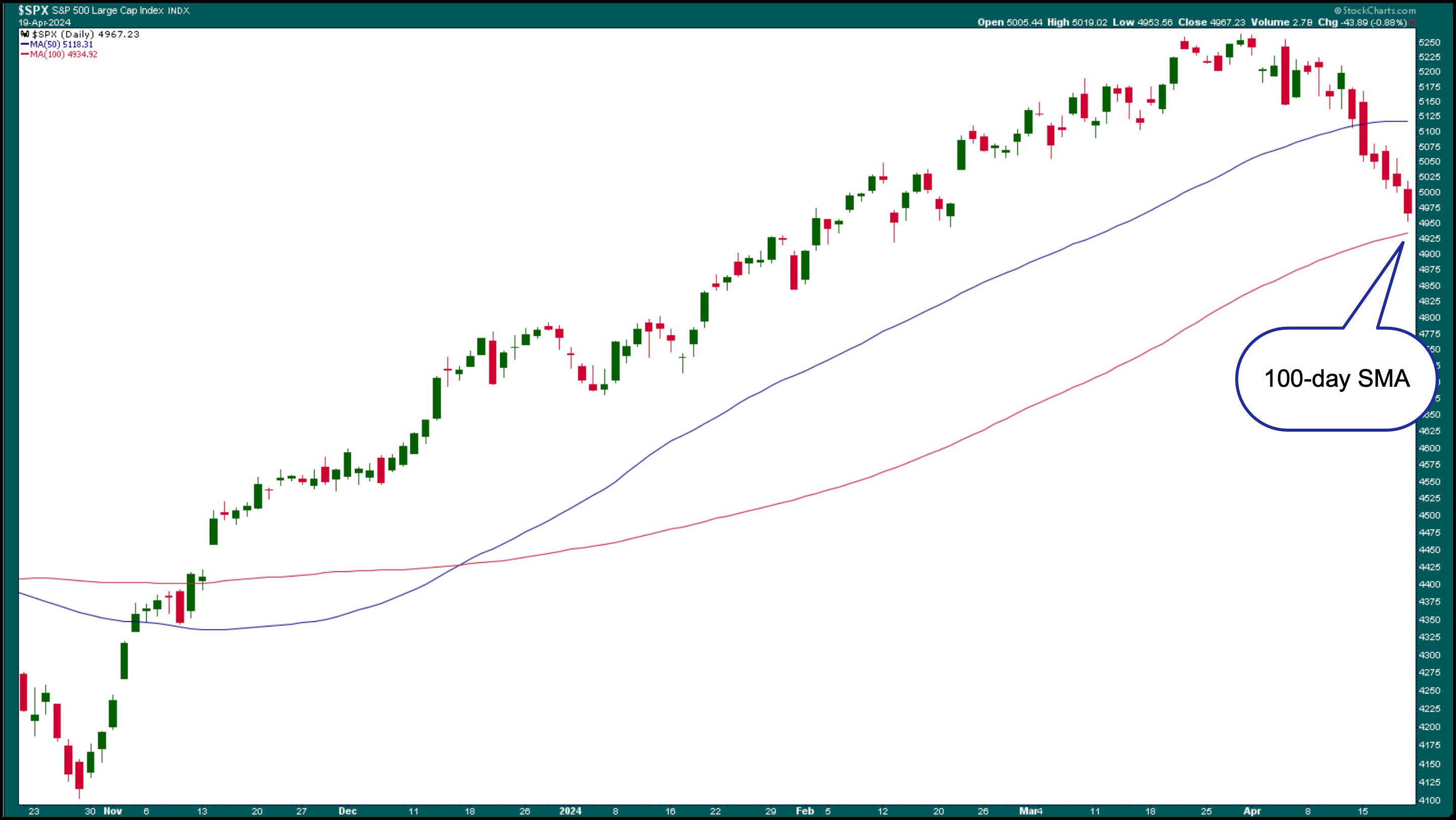
FIGURE 1. DAILY CHART OF THE S&P 500. Since the S&P 500 fell below its 50-day SMA, it's taken the elevator down. The index is now approaching its 100-day SMA, which could be its next support level. Will it fall below the support?Chart source: StockCharts.com. For educational purposes.
On the weekly chart, the S&P 500 is above its 50-week SMA, but has three consecutive down weeks, which doesn't paint a pretty picture. Right now, it looks as if the index has further to fall.
The Dow Jones Industrial Average
After its most recent selloff, the Dow Jones Industrial Average ($INDU) is trading around a support level (December 2023 high). The daily chart below shows that even though the index closed higher on Friday, it hit resistance from its 100-day SMA.
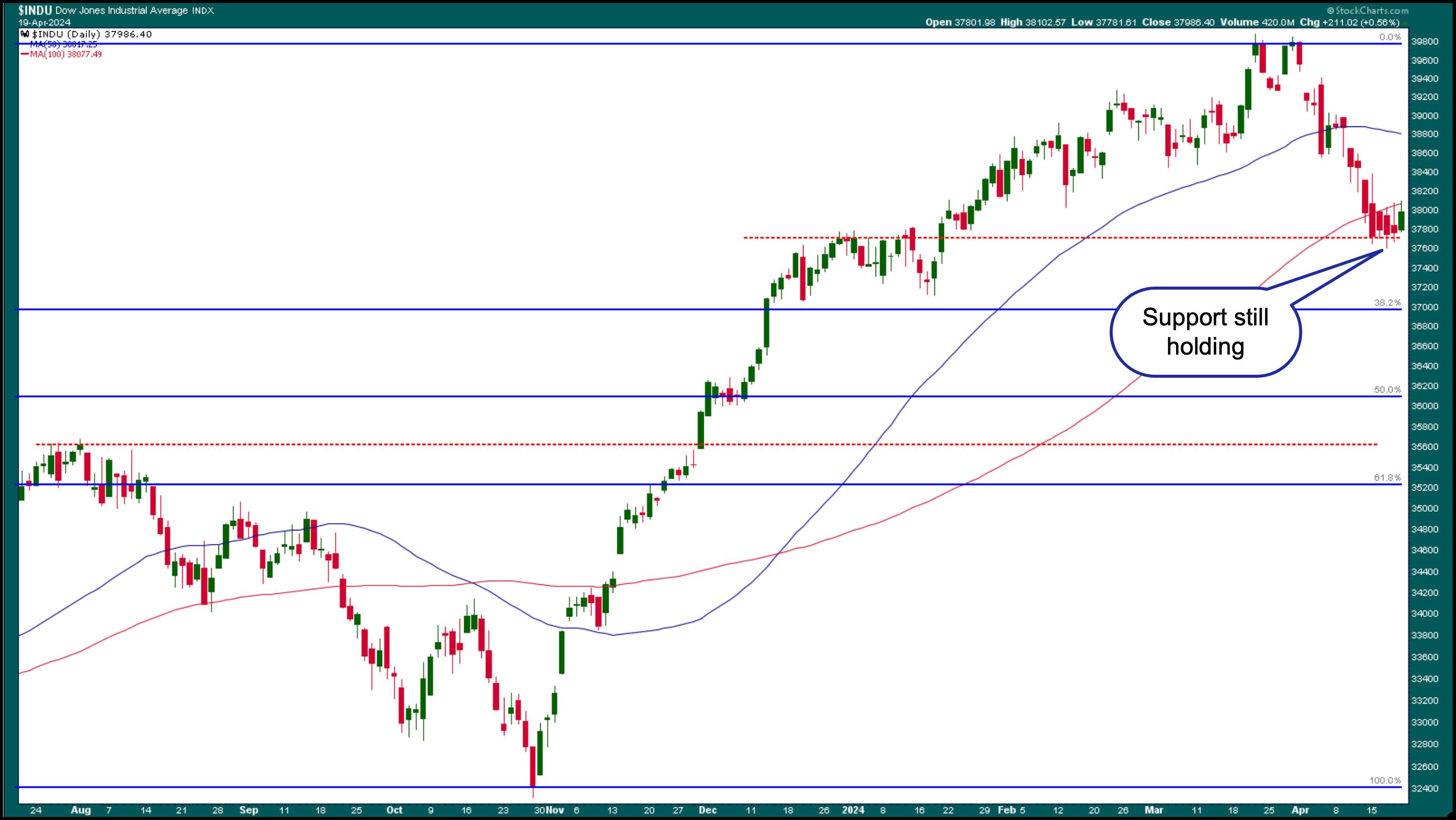
FIGURE 2. DAILY CHART OF DOW JONES INDUSTRIAL AVERAGE ($INDU). After its elevator ride down, $INDU appears to have hit a support level and trying to reverse, which is a positive sign.Chart source: StockCharts.com. For educational purposes.
The Nasdaq Composite
The Technology sector was hit hard this week. NVIDIA (NVDA) fell over 9% on Friday; Tesla (TSLA) shares continued to fall, hitting a new 52-week low; and Advanced Micro Devices (AMD) fell over 5%.
Super Micro Computers (SMCI), which has been in the top 5 StockCharts Technical Rank (SCTR) for months, fell over 23%. The selloff was caused by the company's decision not to preannounce its earnings results as it has in the past.
Looks like investors were taking their Tech stock profits. As a result of the big Tech selloff, the Nasdaq Composite is trading below its 100-day SMA (see chart below).
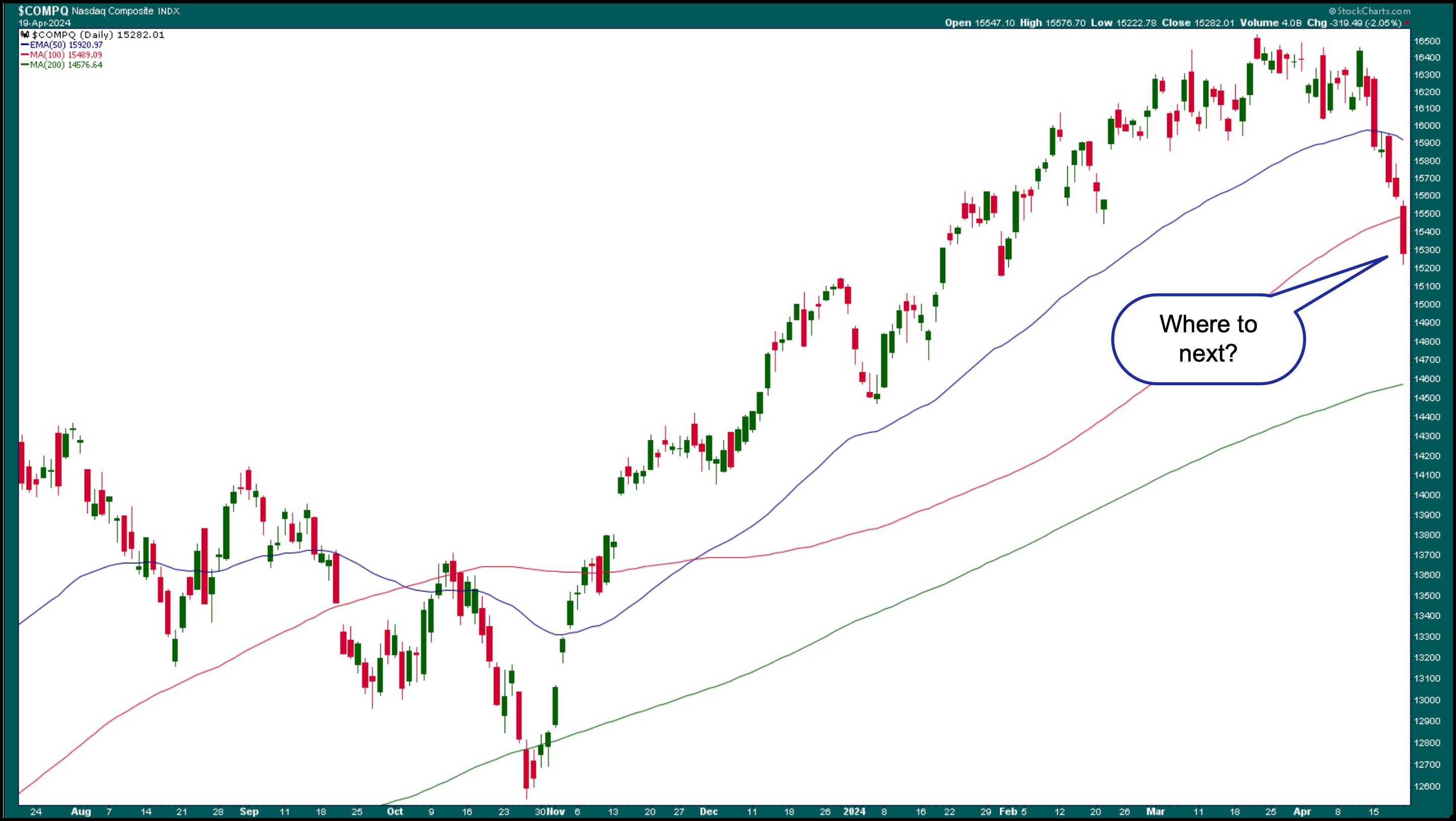
FIGURE 3. DAILY CHART OF NASDAQ COMPOSITE. After falling below its 100-day SMA, the Nasdaq Composite could slide to its 200-day SMA. The small wick at the bottom is slightly encouraging, but next week is another week.Chart source: StockCharts.com. For educational purposes.
Whenever there's a massive selloff, as was the case this week, investors question whether the market has hit a bottom and if it's an ideal time to open long positions. There was a little bit of that on Friday, but every time the market rallied, it met pressure from sellers and the rally fizzled. When technicals still point lower, you may want to adopt a "wait and see" approach before entering long positions.
Nobody knows what will happen next week, but tech companies will start reporting earnings, and that could lift the stock market.
Some Bright Spots
After experiencing a plunge similar to that of the broader indexes, the Financial sector is showing signs of a reversal. The daily chart of the Financial Select Sector SPDR (XLF) below shows a possible reversal, although a series of higher highs and higher lows is needed before an uptrend can be established. XLF would need to break above.
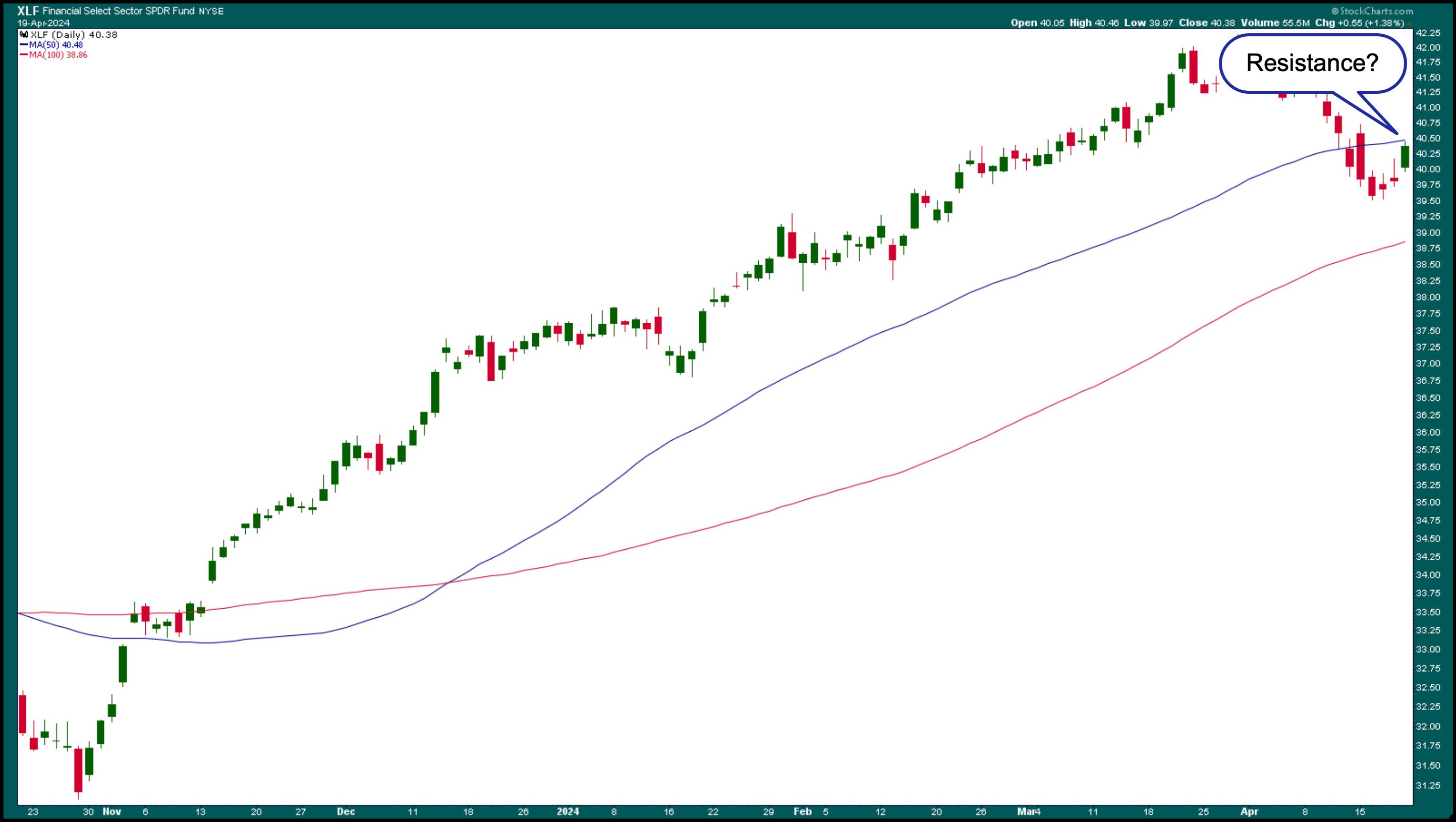
FIGURE 4. DAILY CHART OF FINANCIAL SELECT SECTOR SPDR ETF (XLF). Looks like XLF will have to overcome the resistance from its 50-day moving average before its trend reverses.Chart source: StockCharts.com. For educational purposes.
Shares of Bank of America (BAC), JP Morgan Chase (JPM), Citigroup (C), and Wells Fargo (WFC) all traded higher on Friday. WFC's stock price reached a new all-time high. Precious metals, such as gold and silver, are trading higher. As geopolitical tensions arise, investors turn to these safe-haven investments.
It was interesting to see the CBOE Volatility Index ($VIX) hit a high of 21.36, close to the 23 level it hit in October last year. But it pulled back and closed at 18.71. The higher volatility could have been because of options expiration.
If you look at the chart of the Nasdaq Composite, you'll see that this coincided with the October selloff in Tech stocks. Will the broader markets follow a similar path, given Tech earnings start next week? We'll have to wait and see.
The Bottom Line
This week's stock market action wasn't great, and while it's tempting to find bargains in stocks, it's best to exercise patience. Instead of chasing positions, it's an excellent time to analyze charts and observe the market's actions. This can go a long way in understanding the irrational nature of the stock market.
End-of-Week Wrap-Up

- S&P 500 closes down 0.88% at 4,967.23, Dow Jones Industrial Average up 0.56% at 37,986; Nasdaq Composite down 2.05% at 15,282.01
- $VIX up 3.94% at 18.71
- Best performing sector for the week: Utilities
- Worst performing sector for the week: Technology
- Top 5 Large Cap SCTR stocks: MicroStrategy Inc. (MSTR); Coinbase Global Inc. (COIN); Super Micro Computer, Inc. (SMCI); Vistra Energy Corp. (VST); Vertiv Holdings (VRT)
On the Radar Next Week
- Q1 2024 US GDP
- March Core PCE
- March Durable Goods Orders
- Earnings season is in full swing with Alphabet (GOOGL), Meta Platforms (META), Microsoft (MSFT), Intel Corp. (INTC), and Visa (V) reporting.
Disclaimer: This blog is for educational purposes only and should not be construed as financial advice. The ideas and strategies should never be used without first assessing your own personal and financial situation, or without consulting a financial professional.
|
| READ ONLINE → |
|
|
|
| Trading Places with Tom Bowley |
| Are The Financials Sending Us A Major Warning Signal? |
| by Tom Bowley |
I've said for awhile that we could use some short-term selling to unwind overbought conditions and even negative divergences in some cases. I was looking for perhaps 4-5%, but it's really difficult to predict the kind and depth of selling that we'll see when secular bull markets face a downturn. Personally, I'd be shocked if this recent weakness morphs into a bear market. I'm not saying that it's not possible, but my key signals suggest it's very, very unlikely.
We've seen some downside moves in the past of just 1-2% and others, like the correction last summer, that stretched to 10%. I believe earnings will be strong, but the huge move off the October 2023 low may have built in that positive news. You've probably heard that old Wall Street adage, "buy on rumor, sell on news", right? Well, that's exactly what we saw Friday, with respect to the major financials that reported quarterly results Friday morning. The earnings numbers looked pretty good on Zacks:
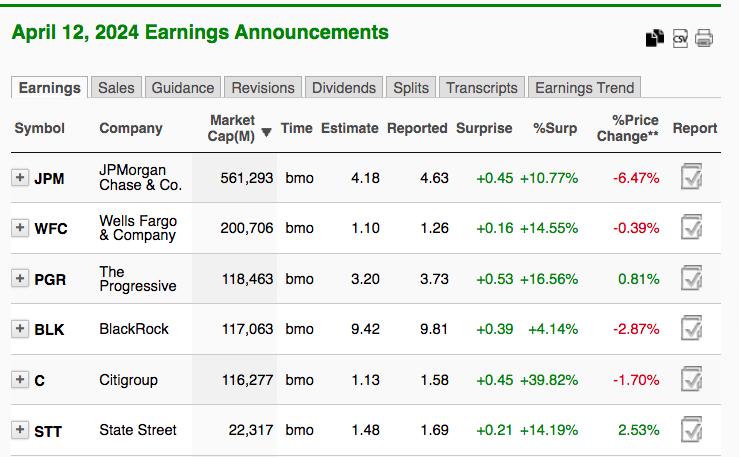
Reported EPS was significantly higher than estimates in every case. Citigroup (C), in particular, crushed estimates, blowing them away by nearly 40%. There were revenue beats by all 6 companies as well:
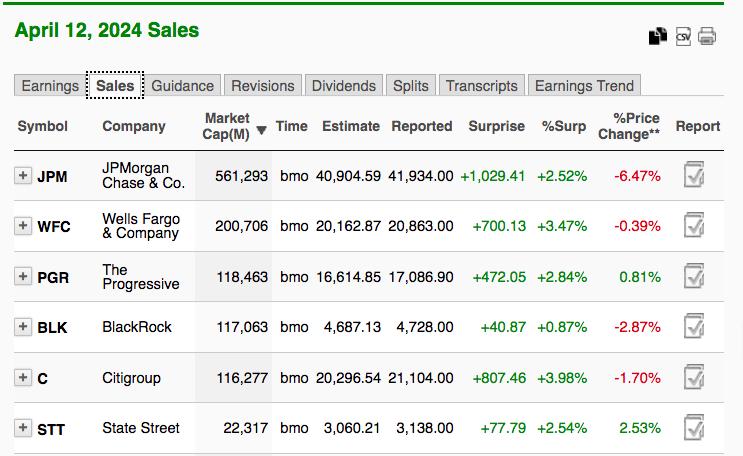
Again, it was C that posted the best revenue beat - nearly 4% higher than expectations. From these tremendous numbers, it's easy to NOW see why financials had performed so well.
But one thing that confuses many retail traders is that strong results do not always translate into higher stock prices. Check out the quarterly earnings price reactions on these 6 stocks:
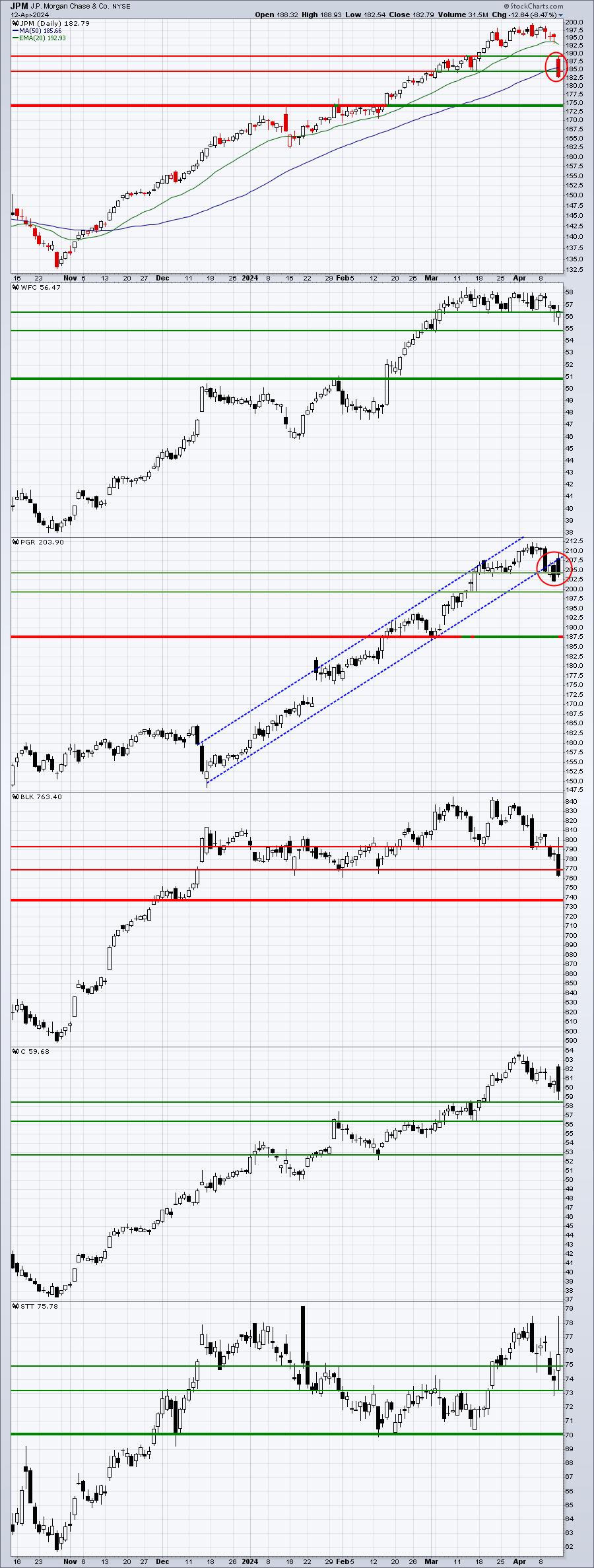
Is this type of market reaction justified after seeing those quarterly results? I don't think so, but the stock market doesn't care what I think. Market makers have a job to do - build positions for their institutional clients at our expense. The short-term is NOT efficient. Prices don't do what you think they'll do. Then you get confused, believing financial stocks are dead. After they drop for awhile, you panic and sell and, after market makers get all the shares they need, financials regain their strength. This is what the stock market does. The short-term inefficiencies wear on traders, causing them to give up, and that creates supply for market makers to build their inventory. Then rinse and repeat. As the late great Yogi Berra would say, "it's deja vu all over again!"
I discussed why we can't trust this selling in my latest EB Weekly Market Recap VIDEO, "Hot CPI Stokes Inflation Fears". The secular bull market remains perfectly intact. Check it out and leave me a comment. Also, please "LIKE" the video and "SUBSCRIBE" to our YouTube channel, if you haven't already. It'll help us build our YouTube community and I would certainly appreciate it.
On Monday, April 15th, I'll be providing another financial stock that is poised to report excellent quarterly results. This company has been a huge leader among its peers, suggesting a blowout report ahead. If financials reverse their current weakness, I would not be surprised to see a very POSITIVE market reaction to this company's report. To receive this company and check out its chart, simply CLICK HERE to subscribe to our FREE EB Digest newsletter. There is no credit card required to join the EB Digest, just your name and email address!
Happy trading!
Tom
|
| READ ONLINE → |
|
|
|
| DecisionPoint |
| Netflix Gets Island Reversal On Earnings |
| by Carl Swenlin |
Netflix (NFLX) earnings were released today, and the news was good. . . except for one little thing. They also suspiciously announced that, starting next year, they would no longer be reporting subscriber metrics. That's like General Motors saying that they will no longer report how many cars and trucks they made. I admit that some other aspect of the report could be a contributing factor for the crash, but let's look at the technicals.
After the gap up in January, price formed a three-month island that drifted higher, but all was not well technically. The falling PMO formed a negative divergence against the rising price. When the PMO falls above the zero line, it is telling us that the strength behind the up move is diminishing.
Also, the On-Balance Volume (OBV) went flat to slightly falling. OBV usually tracks price, and when it doesn't, it should attract our attention. In this case, it is suggesting that NFLX is not attracting sufficient volume to justify the rise in price.
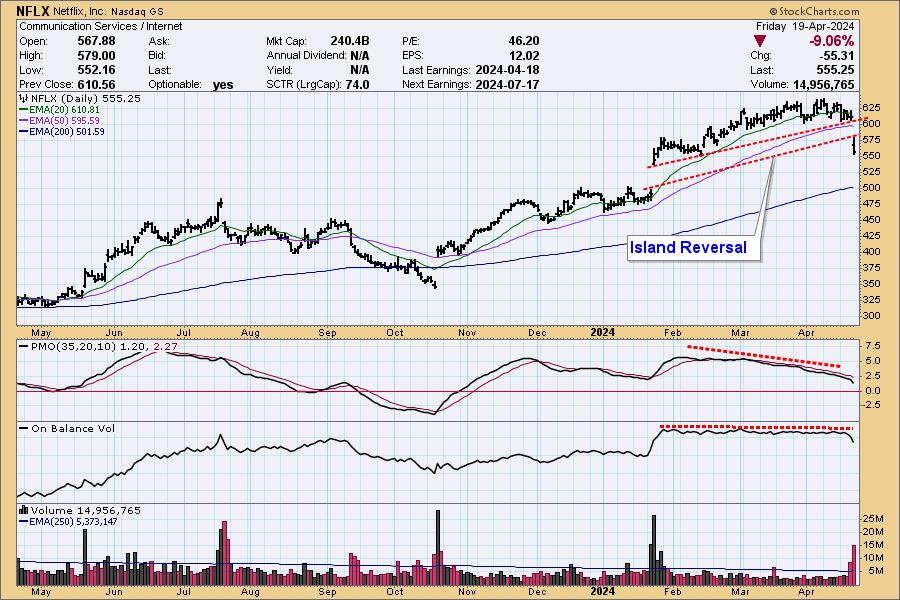
Conclusion: Gaps don't always result in island reversals. For example, there was a gap up in October, following which a very similar island was formed. However, in January price gapped up from that island instead of reversing. In the case of the latest island, OBV sent up the warning flag.
Learn more about DecisionPoint.com:
Watch the latest episode of the DecisionPointTrading Room on DP's YouTube channel here!

Try us out for two weeks with a trial subscription!
Use coupon code: DPTRIAL2 at checkout!
Technical Analysis is a windsock, not a crystal ball. --Carl Swenlin
(c) Copyright 2024 DecisionPoint.com
Disclaimer: This blog is for educational purposes only and should not be construed as financial advice. The ideas and strategies should never be used without first assessing your own personal and financial situation, or without consulting a financial professional. Any opinions expressed herein are solely those of the author, and do not in any way represent the views or opinions of any other person or entity.
DecisionPoint is not a registered investment advisor. Investment and trading decisions are solely your responsibility. DecisionPoint newsletters, blogs or website materials should NOT be interpreted as a recommendation or solicitation to buy or sell any security or to take any specific action.
Helpful DecisionPoint Links:
Trend Models
Price Momentum Oscillator (PMO)
On Balance Volume
Swenlin Trading Oscillators (STO-B and STO-V)
ITBM and ITVM
SCTR Ranking
Bear Market Rules
|
| READ ONLINE → |
|
|
|
| Don't Ignore This Chart! |
| META Stock in Limbo: What You Need to Know Before the Next Big Price Swing |
| by Karl Montevirgen |

Meta Platforms Inc. (META), the social media giant formerly known as Facebook, has been in tight consolidation at the top of its range for a little over a month. Following a 23% rise in February after its Q4 earnings, trading volume for the stock has declined significantly. Market participants are now looking for any catalyst that could guide the stock's movement.
Analyst Price Predictions Show Wide Variation
If you're undecided as to whether you're bullish or bearish on Meta, you're not alone, as the blogosphere will show you a wide range of analyst price predictions for the next 12 months. The highest price target is at $610, average consensus is at $489, and the lowest price targets average around $272.
Yet, consensus ratings lean from "Buy" to "Strong Buy."
What's New with Meta? It's New AI Rollout
The bullish outlook is driven by its new AI app, Meta AI, which aims to boost user engagement across WhatsApp, Instagram, Facebook, and Messenger by providing advanced AI capabilities such as animations and image generation. Supported by partnerships with Alphabet (GOOGL) and Microsoft (MSFT), Meta AI will likely see ad revenue growth, prompting analysts to raise their stock price targets.
A Macro Look at Meta

CHART 1. WEEKLY CHART OF META. Hovering at record highs, Meta's uptrend appears to be leaning toward the parabolic side of things, prompting investors to wonder whether such a trajectory is sustainable. The 13-week SMA represents one quarter.Chart source: StockCharts.com. For educational purposes.
Having gone the distance to bounce off its 2022 lows, Meta began outperforming the S&P 500 just this year, now besting the broader market by 37%.
However, before even matching the broader market. Meta's technicals—as shown by its StockCharts Technical Rank (SCTR) score—have been remarkably strong (with a score above the 90-line) since the end of 2022.
The 13-week simple moving average, representing one quarter, appears to be a consistent proxy for support and resistance. You will want to watch that line when looking at Meta using a weekly chart.
A Near-Term View of Meta's Price Action
Analyst consensus may be largely bullish, and the Meta AI rollout is prompting Wall Street to raise price targets upward, with some going as high as $610. However, right now, we're seeing a rectangle pattern and, technically, Meta's price can go either direction, at least in the near term (see chart below).

CHART 2. DAILY CHART OF META. The momentum, or lack thereof, says a lot. Investors are probably waiting for the META's next earnings report, scheduled for April 24.Chart source: StockCharts.com. For educational purposes.
Mind the Rectangle: If you're looking to take action upon a breakout, set a price alert at $481 near the bottom and $531 near the top of the formation.

Mind the Momentum: Fundamental forecasts may be bullish, but the Chaikin Money Flow (CMF) will tell you that selling pressure is currently far greater, though there isn't that much activity, bullish or bearish, taking place right now. And why not?
Earnings Coming Up: Meta's last earnings report catapulted the stock to record highs. The next earnings date is on April 24. You'll likely see more activity occurring close to Meta's earnings date. So pay close attention to this.
Support Levels: If Meta's earnings are so-so but not bad enough to invalidate its longer-term bullish thesis (AI rollout), or if its price breaks below the current rectangle formation and the 50-day simple moving average (causing it to trade technically toward the downside), then note the wide support range projected via the Ichimoku Cloud. If the bullish fundamental thesis holds out, buyers will likely jump in within the cloud.
The Bottom Line
Meta's long-term prospects look bullish, much of which is being driven by the optimistic expectations surrounding its AI rollout, Meta AI. Still, it seems poised for a correction, though its chart formation indicates it can go either way. Watch out for any catalysts that could influence the stock's trajectory as the next earnings date approaches. And if Meta does take a dip, keep an eye on that cloud, should the bullish fundamental outlook persist.
Disclaimer: This blog is for educational purposes only and should not be construed as financial advice. The ideas and strategies should never be used without first assessing your own personal and financial situation, or without consulting a financial professional.
|
| READ ONLINE → |
|
|
|
| MORE ARTICLES → |
|




































